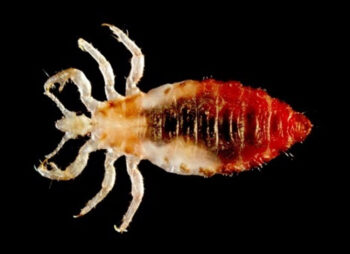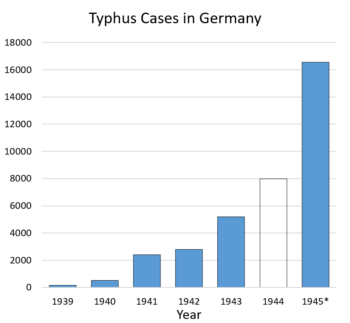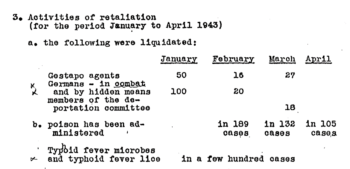Typhus

Typhus fevers are a group of diseases caused by bacteria that are transmitted by parasitic insects, such as fleas, lice and chiggers. In the context of the Holocaust, epidemic typhus is relevant. Epidemic typhus is also sometimes called European, classic, or louse-borne typhus, as well as jail fever. The disease is caused by the bacteria rickettsia prowazekii. It was discovered in 1910 by Howard Ricketts and in 1913 by Stanislaus Prowazek. It is a micro-organism found in the intestines and salivary glands of infected lice.
Whereas typhus is the term commonly used in English to refer to all diseases caused by various rickettsia bacteria, the German term for epidemic typhus is “Fleckfieber.” This German term’s literal translation into English – “spotted fever” – is used in the English language for a different disease, the Rocky Mountain Spotted Fever, which is transferred by ticks.
The symptoms of epidemic typhus are high fever, obstruction of the throat, rapid breathing, coughing, body and muscle aches, vomiting and nausea. Dehydration and a rapid loss of body weight compound the disease. Most important in this context is a marked psychosis at the peak of the illness, an incessant state of delirium. The word typhus actually comes from the Greek word “τυφος”, figuratively meaning stupor, referring to the frenzy developed by the sick. It results in nightmarish delusions which, if not treated therapeutically, can mislead cured patients to think that their deluded imaginations were real experiences.

During World War II, German authorities desperately tried finding an efficient vaccination against the disease, among them by experimenting with new vaccine candidates on concentration-camp inmates. These experiments were ultimately unsuccessful. To this day, there is no vaccination against this disease.
Epidemic typhus has been endemic in eastern Europe for centuries, and has caused repeated epidemic outbreaks, causing the death of thousands and even millions. During times of war, typhus and dysentery killed more people in Europe than did wounds inflicted by armed conflict. Typhus was extinct in Germany by the late 1800s, but it returned during World War I through the eastern front, claiming thousands of lives among German soldiers. Drastic measures to disinfest soldier’s clothes were implemented.
The same scenario unfolded again during World War II, intensely exacerbated by the many overcrowded labor, concentration and PoW camps with insufficient sanitary and hygienic facilities. Disastrous outbreaks of the disease in camps such as Auschwitz (1942/43) and Bergen-Belsen (late 1944/45) caused tens of thousands of inmates to lose their lives. Massive attempts were made to suppress the disease with improved sanitary camp facilities and lice-killing insecticides such as Zyklon B and DDT, as well as other techniques, such as hot-air and microwave disinfestation. However, these measures collapsed at war’s end, when no supplies reached the camps anymore due to Germany’s destroyed production and transport infrastructure.

Some preposterous eyewitness accounts about alleged experiences at camps such as Auschwitz may be partly explained by nightmarish fantasies which accompany the disease. Tens of thousands of inmates contracted the disease there, and many of them ultimately survived it due to German medical care. Of course, none of them received any therapy afterwards to process their psychotic delusions.
(For more details, see Humm 2004; Rudolf 2004a; 2020, pp. 68-70; 2023, pp. 374-376.)

You need to be a registered user, logged into your account, and your comment must comply with our Acceptable Use Policy, for your comment to get published. (Click here to log in or register.)